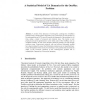Free Online Productivity Tools
i2Speak
i2Symbol
i2OCR
iTex2Img
iWeb2Print
iWeb2Shot
i2Type
iPdf2Split
iPdf2Merge
i2Bopomofo
i2Arabic
i2Style
i2Image
i2PDF
iLatex2Rtf
Sci2ools
GECCO
2004
Springer
2004
Springer
A Statistical Model of GA Dynamics for the OneMax Problem
A model of the dynamics of solving the counting-ones (OneMax) problem using a simple genetic algorithm (GA) is developed. It uses statistics of the early generations of GA runs to describe the dynamics of the problem for all time, using a variety of crossover and mutation rates. The model is very practical and can be generalized to cover other cases of the OneMax, such as weighted OneMax, as well as the deceptive function problem, for high enough crossover rates. Proportional selection with and without Boltzmann scaling have been modeled; however the Boltzmann extensions are not described here. In the development of the model, we introduce a new quantity that measures the effect of the crossover operation in the counting-ones problem and is independent of generation, for practical purposes.
| Added | 01 Jul 2010 |
| Updated | 01 Jul 2010 |
| Type | Conference |
| Year | 2004 |
| Where | GECCO |
| Authors | Bulent Buyukbozkirli, Erik D. Goodman |
Comments (0)

